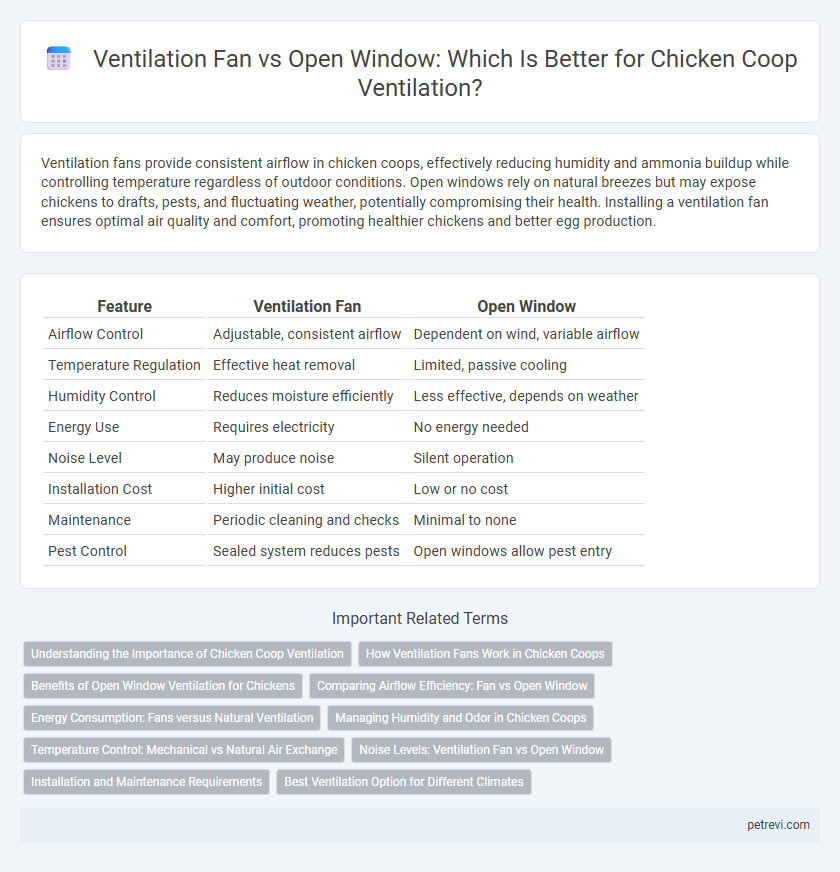Ventilation fans provide consistent airflow in chicken coops, effectively reducing humidity and ammonia buildup while controlling temperature regardless of outdoor conditions. Open windows rely on natural breezes but may expose chickens to drafts, pests, and fluctuating weather, potentially compromising their health. Installing a ventilation fan ensures optimal air quality and comfort, promoting healthier chickens and better egg production.
Table of Comparison
| Feature | Ventilation Fan | Open Window |
|---|---|---|
| Airflow Control | Adjustable, consistent airflow | Dependent on wind, variable airflow |
| Temperature Regulation | Effective heat removal | Limited, passive cooling |
| Humidity Control | Reduces moisture efficiently | Less effective, depends on weather |
| Energy Use | Requires electricity | No energy needed |
| Noise Level | May produce noise | Silent operation |
| Installation Cost | Higher initial cost | Low or no cost |
| Maintenance | Periodic cleaning and checks | Minimal to none |
| Pest Control | Sealed system reduces pests | Open windows allow pest entry |
Understanding the Importance of Chicken Coop Ventilation
Proper chicken coop ventilation prevents moisture buildup and harmful ammonia levels, essential for maintaining healthy respiratory conditions in chickens. Ventilation fans provide controlled airflow, enhancing air exchange even in poor weather, whereas open windows rely on natural wind but may result in inconsistent airflow. Choosing the right ventilation method reduces heat stress and improves overall flock health and egg production.
How Ventilation Fans Work in Chicken Coops
Ventilation fans in chicken coops actively circulate air by drawing fresh air in and expelling stale air, maintaining optimal temperature and humidity levels crucial for poultry health. These fans prevent the buildup of ammonia and moisture, reducing respiratory issues and promoting a comfortable environment for chickens. Unlike open windows, ventilation fans provide consistent airflow regardless of external weather conditions, enhancing air quality and coop cleanliness.
Benefits of Open Window Ventilation for Chickens
Open window ventilation in chicken coops promotes natural airflow, reducing humidity and ammonia buildup to improve air quality and respiratory health for chickens. It provides consistent fresh air circulation without the noise and energy consumption associated with ventilation fans. This method is cost-effective, easy to maintain, and supports a more natural environment that helps prevent heat stress and respiratory issues in poultry.
Comparing Airflow Efficiency: Fan vs Open Window
Ventilation fans provide consistent and controlled airflow in chicken coops, enhancing air exchange rates and reducing humidity more effectively than open windows. Open windows rely on natural wind conditions, resulting in variable airflow that may not sufficiently remove ammonia buildup or moisture during calm weather. Fans optimize ventilation by maintaining steady air movement, crucial for preventing respiratory issues and promoting healthier poultry environments.
Energy Consumption: Fans versus Natural Ventilation
Ventilation fans in chicken coops consume electrical energy, offering controlled airflow and consistent ventilation regardless of external weather conditions. Open windows provide natural ventilation without energy costs but rely on ambient wind and temperature, potentially leading to inconsistent airflow and temperature regulation. Energy consumption is zero for open windows, making them cost-effective, while fans may increase operational expenses but ensure optimal air exchange and humidity control.
Managing Humidity and Odor in Chicken Coops
A ventilation fan in a chicken coop provides consistent airflow that effectively controls humidity levels and reduces ammonia odor, preventing respiratory issues in birds. Open windows rely on natural breeze and temperature differences, which can be insufficient during stagnant weather, leading to moisture buildup and odor accumulation. Optimizing coop ventilation with fans ensures better air exchange rates, maintaining a healthier environment for chickens by managing humidity and minimizing foul smells.
Temperature Control: Mechanical vs Natural Air Exchange
Ventilation fans provide consistent airflow that precisely regulates temperature inside chicken coops, preventing heat buildup and promoting poultry health during extreme weather. Open windows rely on natural air exchange driven by wind and temperature differences, which can lead to fluctuating temperatures and less effective cooling. Mechanical ventilation ensures steady climate control, while natural methods depend on environmental conditions, impacting overall coop temperature stability.
Noise Levels: Ventilation Fan vs Open Window
Ventilation fans in chicken coops generate consistent mechanical noise that may disrupt chickens' rest and lead to stress, while open windows provide natural airflow with minimal sound interference, promoting a quieter environment. Noise levels from fans typically range between 40-60 decibels, which can be significant in small, enclosed spaces. In contrast, open windows rely on ambient outdoor sounds, reducing overall noise impact and enhancing poultry comfort.
Installation and Maintenance Requirements
Installing a ventilation fan in a chicken coop requires electrical wiring, mounting hardware, and occasional motor lubrication, ensuring consistent airflow and temperature control. In contrast, an open window offers a simpler setup with minimal installation and no mechanical parts, but may require frequent manual adjustments and cleaning to optimize ventilation. Maintenance of fans involves periodic inspection for dust buildup and motor wear, whereas windows need regular cleaning and protection against weather elements to maintain effectiveness.
Best Ventilation Option for Different Climates
Ventilation fans provide controlled airflow and consistent air exchange, making them ideal for hot and humid climates where maintaining stable temperature and humidity levels is crucial for chicken health. Open windows offer natural ventilation suited for mild or cooler climates, allowing fresh air circulation without the risk of over-drying or excessive cooling. Selecting the best ventilation method depends on climate; fans excel in extreme weather, while windows are effective in moderate environments.
Ventilation Fan vs Open Window for Chicken Coop Ventilation Infographic

 petrevi.com
petrevi.com